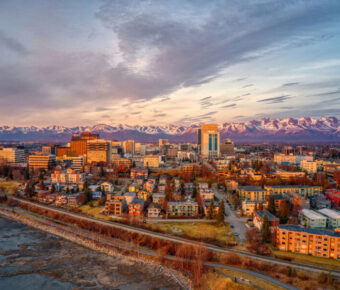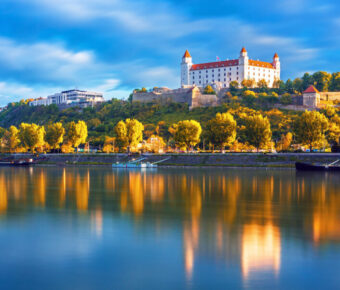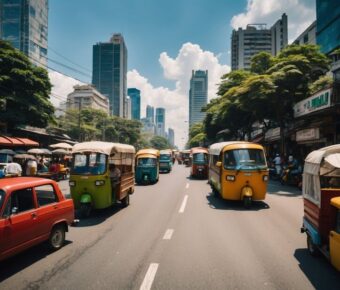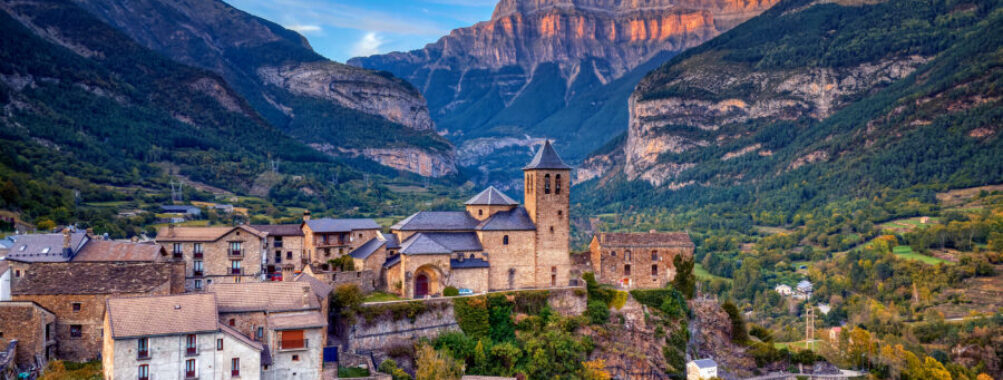
15 Hidden Mountain Towns in Europe That Rival the Alps (But Cost Half as Much)
Escape the €300-per-night Alpine resorts and discover Europe’s best-kept mountain secrets—where stunning peaks meet budget-friendly prices
Picture this: You’re sipping morning coffee on a mountain terrace, gazing at snow-capped peaks that pierce the clouds. The scene could easily be Zermatt or Chamonix, but your hotel bill says €45 instead of €450. Welcome to Europe’s hidden mountain towns—destinations that deliver all the Alpine magic without the Swiss price tags.
While Instagram influencers crowd the usual suspects, savvy travelers are discovering equally spectacular mountain towns across Eastern and Southern Europe. These affordable mountain towns Europe has quietly kept to itself offer the same dramatic peaks, pristine lakes, and charming villages, at prices that won’t require a second mortgage. From Romania’s mystical Carpathians to Albania’s untouched Accursed Mountains, these 15 destinations prove that budget travel and breathtaking scenery aren’t mutually exclusive.
Ready to trade tourist traps for authentic mountain culture? Let’s explore Europe’s most stunning Alpine alternatives where your euro stretches twice as far.
Table of Contents
- 1. Brașov, Romania – Gateway to the Carpathian Alps
- Getting There & Costs
- Can’t-Miss Experiences
- Insider Tip
- 2. Zakopane, Poland – The Winter Capital at Your Doorstep
- Getting There & Costs
- Peak Experiences
- Local Flavor
- 3. Žabljak, Montenegro – Europe’s Highest Town
- Getting There & Adventure Base
- Natural Wonders
- When to Visit
- 4. Bansko, Bulgaria – More Than Just Skiing
- Getting There & Budget Breakdown
- Summer Highlights
- Cultural Immersion
- 5. Bled, Slovenia – Fairytale Views, Real-World Prices
- Getting There & Costs
- Beyond the Obvious
- Adventure Extensions
- 6. Kranjska Gora, Slovenia – Triglav’s Basecamp
- Getting There & Mountain Access
- Hiking Heaven
- Year-Round Appeal
- 7. Sighișoara, Romania – Medieval Magic Meets Mountains
- Getting There & Atmosphere
- Timeless Exploration
- Day Trip Potential
- 8. Poprad, Slovakia – High Tatras Hub
- Getting There & Strategic Location
- Peak Experiences Without Peak Prices
- Thermal Bonus
- 9. Bovec, Slovenia – Emerald River Paradise
- Getting There & Adventure Costs
- Natural Wonders
- Adrenaline Capital
- 10. Valbona, Albania – Europe’s Last Frontier
- Getting There & True Adventure
- Pristine Wilderness
- Cultural Immersion
- 11. Torla-Ordesa, Spain – Pyrenean Perfection
- Getting There & Park Logistics
- Dramatic Landscapes
- Medieval Charm
- 12. Štrbské Pleso, Slovakia – Glacial Lake Luxury
- Getting There & Resort Reality
- Lake Life
- Four-Season Appeal
- 13. Theth, Albania – The Village Time Forgot
- Getting There & Authentic Experience
- Natural Attractions
- Hiking Paradise
- 14. Kolasin, Montenegro – The Accessible Alternative
- Getting There & Comfort Level
- Pristine Nature
- Year-Round Activities
- 15. Aínsa, Spain – Where Mountains Meet History
- Getting There & Practical Magic
- Timeless Wandering
- Adventure Hub
- Planning Your Budget Mountain Escape
- When to Go
- Budget Breakdown (per person/day)
- Essential Gear
- Money-Saving Strategies
- Safety Considerations
- Your Alpine Adventure Awaits
- Book Your Dream Experience
- More Travel Guides
1. Brașov, Romania – Gateway to the Carpathian Alps

Nestled at the foot of Mount Tâmpa, Brașov delivers medieval charm wrapped in mountain majesty. This 13th-century Saxon city serves up Gothic spires, cobblestone streets, and easy access to some of Europe’s most underrated peaks—all at prices that would make Swiss hoteliers weep.
Getting There & Costs
- Location: Central Romania, 170km from Bucharest
- Access: Direct trains from Bucharest (€10, 2.5 hours) or budget flights to nearby airports
- Accommodation: €25-45/night for centrally located hotels (vs. €200-400 in comparable Alpine towns)
- Meals: Traditional Romanian dinner with drinks: €12-18
Can’t-Miss Experiences
The Black Church (Biserica Neagră) dominates the main square, housing Europe’s largest collection of Ottoman carpets. For mountain views, ride the cable car up Mount Tâmpa (€12 return) or hike the marked trail (45 minutes). The nearby Postăvaru Massif offers 50km of hiking trails in summer and affordable skiing in winter (day pass: €30).
Don’t miss a day trip to Bran Castle [Internal link opportunity: “Complete Guide to Romania’s Castles”], marketed as Dracula’s Castle but worth visiting for its dramatic clifftop setting alone.
Insider Tip
Book a room at Casa Wagner (€40/night) in the historic center—this 16th-century merchant house offers authentic Saxon architecture with modern comfort. Request a top-floor room for Carpathian views.
Best Photo Spot: The Council Square (Piața Sfatului) at blue hour, when the medieval buildings glow against the darkening mountain backdrop.
2. Zakopane, Poland – The Winter Capital at Your Doorstep
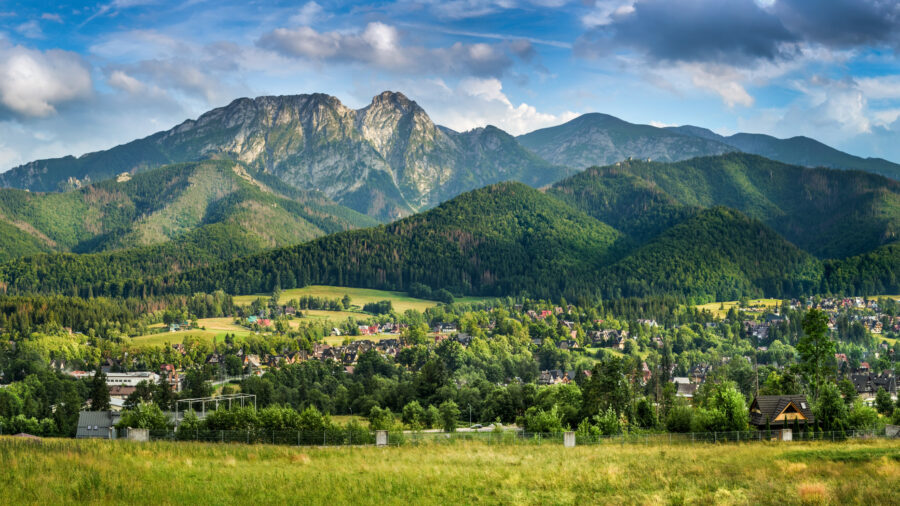
Known as Poland’s “winter capital,” Zakopane combines highlander culture with serious mountain credentials. The Tatra Mountains rising above the town reach 2,499m—proper Alpine heights without Alpine prices.
Getting There & Costs
- Location: Southern Poland, 100km from Kraków
- Access: Direct buses from Kraków (€5, 2 hours) or Warsaw (€15, 6 hours)
- Accommodation: €30-50/night for mountain-view guesthouses
- Meals: Hearty Polish mountain food: €8-15
Peak Experiences
The cable car to Kasprowy Wierch (€22 return) whisks you to 1,987m for panoramic views of both Polish and Slovak Tatras. For an unforgettable hike, tackle the trail to Morskie Oko—Poland’s most photographed mountain lake requires a 9km walk but rewards with emerald waters beneath towering peaks.
Winter transforms Zakopane into an affordable ski destination with six nearby resorts. Kasprowy Wierch offers challenging runs, while Nosal suits beginners (day passes: €25-35).
Local Flavor
Stroll down Krupówki Street for traditional highlander culture—think sheepskin vests, wooden architecture, and oscypek (smoked sheep cheese) grilled over open fires. The pedestrian street buzzes year-round but truly comes alive during winter.
Money-Saving Tip: Stay in nearby villages like Kościelisko or Białka Tatrzańska for even lower prices (€20-30/night) while maintaining easy mountain access.
3. Žabljak, Montenegro – Europe’s Highest Town
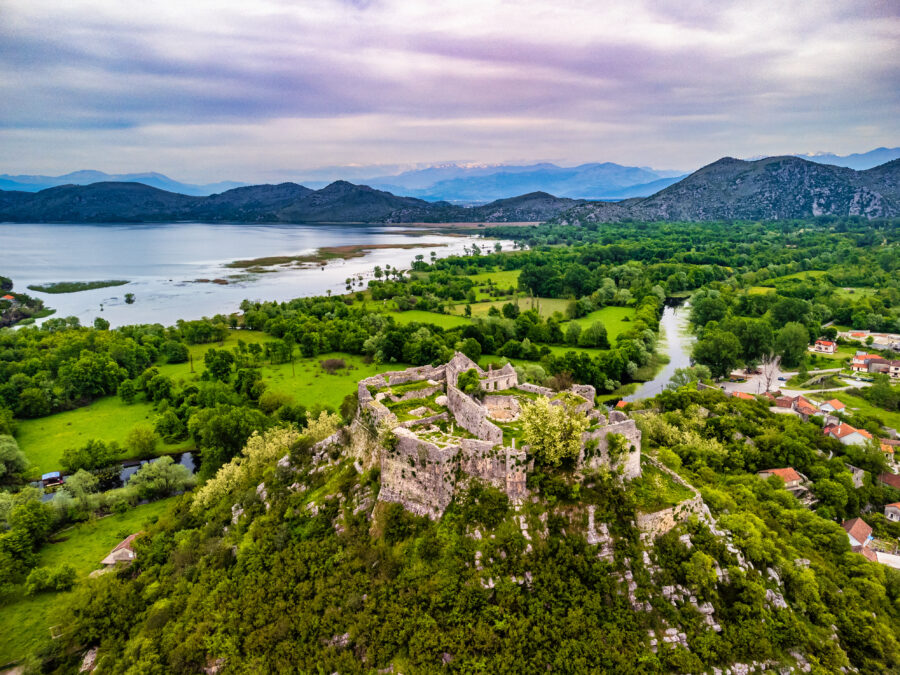
At 1,456m elevation, Žabljak claims the title of the Balkans’ highest town—and gateway to Durmitor National Park’s otherworldly landscapes. Think Dolomites-style limestone peaks, glacial lakes, and Europe’s deepest canyon, all wrapped in Montenegrin prices.
Getting There & Adventure Base
- Location: Northern Montenegro, Durmitor National Park
- Access: Buses from Podgorica (€10, 3 hours) or a rental car recommended
- Accommodation: €25-50/night for park-adjacent lodging
- Park Entry: €3/day (yes, really)
Natural Wonders
Black Lake (Crno Jezero) sits just 3km from town—an easy walk rewards with a glacial lake reflecting jagged peaks. The adventurous should tackle Bobotov Kuk (2,523m), Montenegro’s highest peak, requiring a full day but no technical climbing.
The nearby Tara River Canyon plunges 1,300m—Europe’s deepest gorge offers world-class rafting (€50-80 for day trips) through pristine wilderness.
When to Visit
June through September for hiking; December through March for skiing at modest but scenic Savin Kuk resort (day pass: €20). October brings golden larches but unpredictable weather.
Hidden Gem Alert: Book a traditional meal at Momčilov Grad restaurant—their slow-cooked lamb under the bell (ispod sača) melts off the bone (€12).
4. Bansko, Bulgaria – More Than Just Skiing
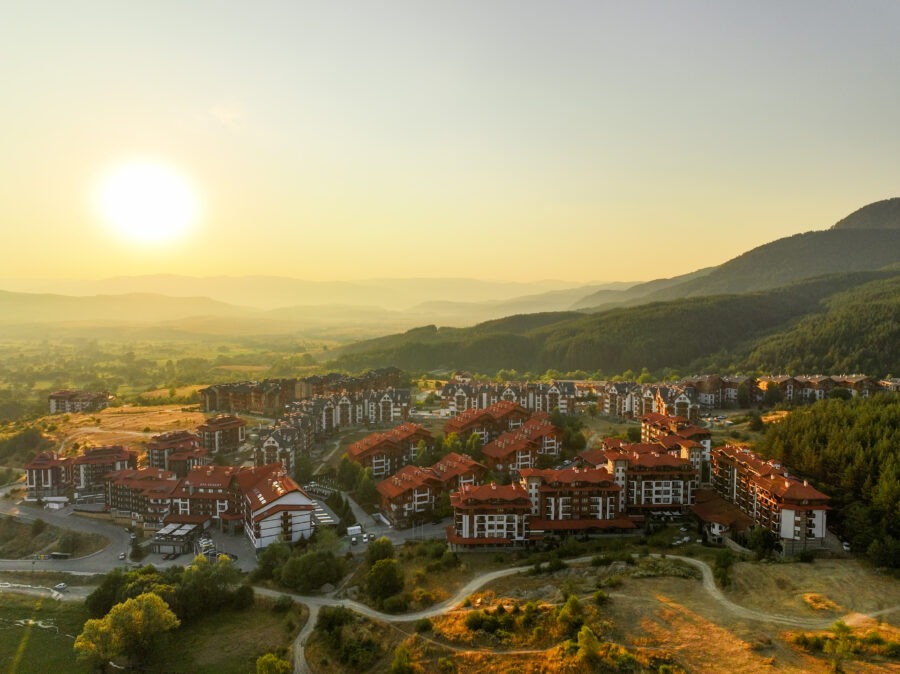
While Bansko built its reputation as Eastern Europe’s premier ski resort, summer reveals the true magic: access to the Seven Rila Lakes and Pirin National Park at bargain prices.
Getting There & Budget Breakdown
- Location: Southwest Bulgaria, Pirin Mountains
- Access: Direct buses from Sofia (€8, 3 hours)
- Accommodation: €20-40/night year-round
- Ski Pass: €35/day (vs. €130+ in major Alpine resorts)
Summer Highlights
The Seven Rila Lakes day trip ranks among Europe’s most spectacular hikes. A chairlift (€12) eliminates the initial climb, leaving a moderate 6-hour circuit past glacial lakes named for their shapes—Kidney, Eye, Twin, and more.
In Pirin National Park, the Vihren Peak trail (2,914m) challenges experienced hikers with Alpine-style terrain and 360-degree views spanning three countries.
Cultural Immersion
Bansko’s Old Town preserves traditional mehana taverns and 19th-century Revival architecture. Don’t miss the Velyanova House Museum—this fortified home showcases how wealthy merchants lived 200 years ago.
Pro Tip: Visit during the annual Bansko Jazz Festival (August) for world-class performances against a mountain backdrop—most concerts are free.
See Related: Best Places to Visit in Europe This Year
5. Bled, Slovenia – Fairytale Views, Real-World Prices
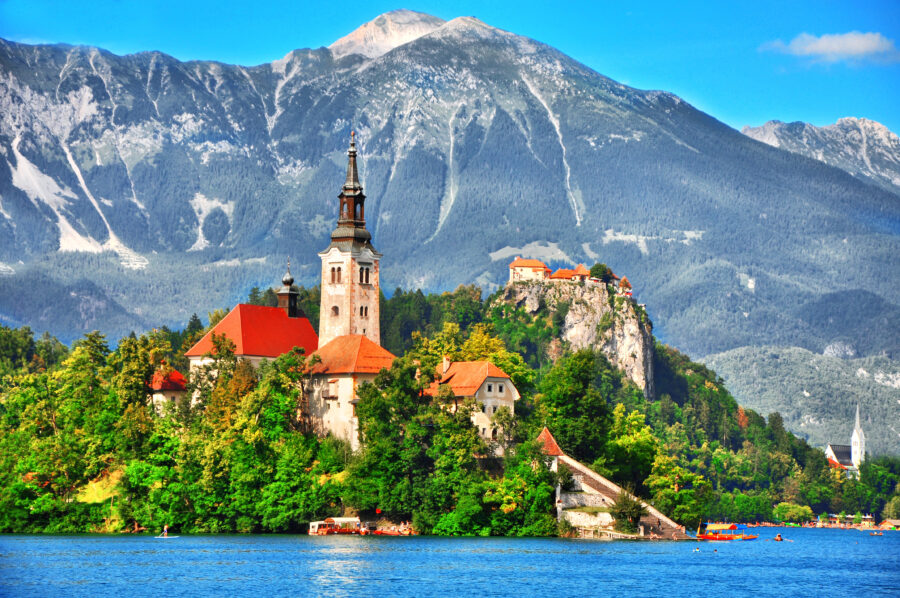
Yes, Bled appears on every Slovenia itinerary, but it earns its spot through sheer beauty-per-euro value. This glacial lake with its island church and clifftop castle delivers Swiss-caliber scenery at Balkan-friendly prices.
Getting There & Costs
- Location: Julian Alps, Northwest Slovenia
- Access: Trains from Ljubljana (€8, 1 hour) or airport shuttles
- Accommodation: €40-80/night for lake-view properties
- Activities: Castle entry €13, traditional pletna boat €18
Beyond the Obvious
While everyone photographs the island church, venture to Vintgar Gorge (€10 entry)—wooden walkways snake through a narrow canyon past waterfalls and emerald pools. Early morning visits mean fewer crowds.
For elevation, hike to Mala Osojnica viewpoint (30 minutes, moderate) for the best lake panorama, especially at sunrise when you’ll likely have it to yourself.
Adventure Extensions
Use Bled as a base for Triglav National Park [Internal link opportunity: “Complete Guide to Slovenia’s National Parks”]. The park’s free entry and well-marked trails offer everything from family strolls to technical mountaineering.
Local Secret: Skip touristy lakeside restaurants for Gostilna Murka in the nearby village—traditional Slovenian fare at half the price (mains €10-15).
6. Kranjska Gora, Slovenia – Triglav’s Basecamp

While Bled gets the glory, Kranjska Gora delivers serious mountain access without the crowds. This unpretentious resort town sits beneath Slovenia’s highest peak, Mount Triglav (2,864m).
Getting There & Mountain Access
- Location: Northwest Slovenia, Italian/Austrian border
- Access: Buses from Ljubljana (€12, 2 hours)
- Accommodation: €45-75/night for Alpine-style lodges
- Triglav National Park: Free entry, well-maintained trails
Hiking Heaven
Lake Jasna offers an easy introduction—two artificial lakes reflect the surrounding peaks just 2km from town. For more challenge, the Vršič Pass road (Slovenia’s highest) provides access to numerous trailheads.
Experienced mountaineers can attempt Mount Triglav itself—a 2-day expedition requiring via ferrata experience but rewarding with national bragging rights.
Year-Round Appeal
Winter brings affordable skiing across five interconnected areas (day pass: €35). The resort suits families and intermediates, with none of the attitude found at famous Alpine destinations.
Money-Saving Move: The Julian Alps Card (€15 for 3 days) includes free parking, discounts on activities, and public transport—quickly pays for itself.
7. Sighișoara, Romania – Medieval Magic Meets Mountains
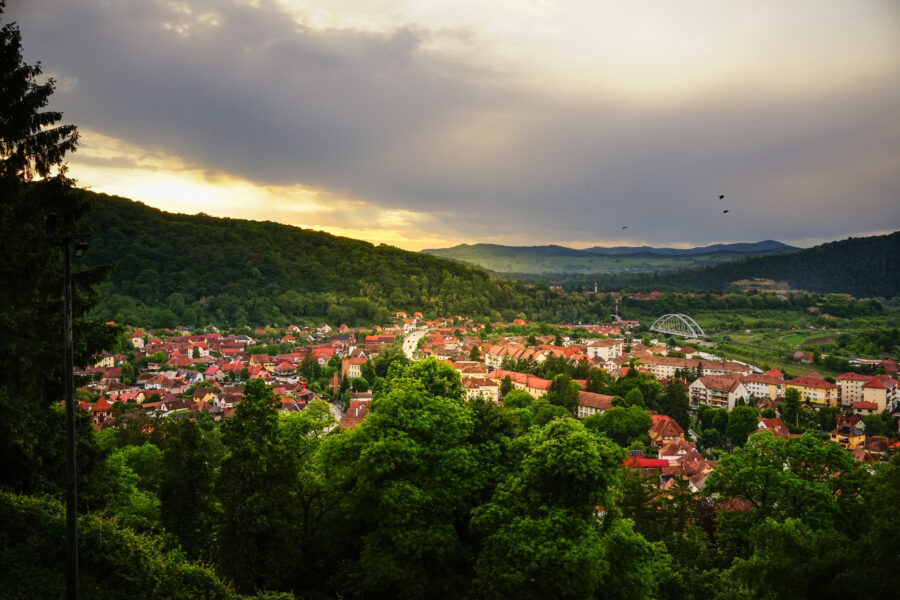
This UNESCO World Heritage citadel might seem an odd mountain town choice, but Sighișoara’s hilltop setting amid the Transylvanian Alps offers a unique blend of history and highland scenery.
Getting There & Atmosphere
- Location: Central Romania, Mureș County
- Access: Trains from Brașov (€5, 2 hours) or Bucharest (€15, 5 hours)
- Accommodation: €20-40/night, including rooms within the medieval citadel
- Citadel Entry: Free to wander, €3 for Clock Tower
Timeless Exploration
The perfectly preserved medieval citadel contains just 160 inhabited houses—Europe’s last inhabited medieval fortress. Climb the Clock Tower for 360-degree views of terracotta roofs against green Carpathian foothills.
The Scholars’ Stairs covered wooden staircase (built 1642) connects the lower town to the hilltop church—175 steps through history with mountain vistas at the top.
Day Trip Potential
Use Sighișoara as a base for exploring Saxon villages like Viscri (Prince Charles owns a house here) or Biertan, both UNESCO sites nestled in Carpathian valleys.
Atmospheric Dining: Book dinner at Casa Wagner in a 16th-century cellar—medieval ambiance with mountain views from the terrace (mains €8-14).
8. Poprad, Slovakia – High Tatras Hub

Often overlooked as merely a transit point, Poprad deserves recognition as an affordable base for exploring the High Tatras—the smallest high mountain range in the world.
Getting There & Strategic Location
- Location: Northern Slovakia, beneath the High Tatras
- Access: Direct Ryanair flights from London, trains from Bratislava (€19, 4 hours)
- Accommodation: €30-50/night with mountain views
- Mountain Access: Electric railway to resort towns (€2-5)
Peak Experiences Without Peak Prices
The cable car to Lomnický štít (€39) ranks among Europe’s most spectacular, ascending to 2,634m for views into Poland and across the Tatras. Book ahead online for significant discounts.
Štrbské Pleso, accessible by historic cog railway, offers a glacial lake surrounded by peaks—easier hiking than the high mountains but equally photogenic.
Thermal Bonus
After mountain adventures, soak at AquaCity Poprad—this geothermal complex offers pools, saunas, and mountain views. Evening tickets (after 6 PM) cost half price (€12).
Strategic Tip: The Tatra Card (€20 for 3 days) includes transport, cable car discounts, and free parking—essential for multi-day exploration.
9. Bovec, Slovenia – Emerald River Paradise

Where the Julian Alps meet the Soča River, Bovec combines mountain grandeur with adventure sports in one of Europe’s most photogenic valleys.
Getting There & Adventure Costs
- Location: Northwest Slovenia, Soča Valley
- Access: Buses from Ljubljana (€15, 3.5 hours) or a rental car are recommended
- Accommodation: €35-60/night for riverside lodges
- Activities: Rafting €45, zip-lining €35, canyoning €65
Natural Wonders
The Soča River glows an impossible emerald green—glacier-fed but warm enough for summer swimming in calmer sections. The Soča Trail follows the river for 20km of easy hiking past pools, waterfalls, and WW1 memorials.
For vertical thrills, the Mount Kanin cable car (€18) accesses high-altitude hiking and year-round snow patches at 2,200m.
Adrenaline Capital
Bovec earned its reputation through adventure sports, utilizing the dramatic terrain. White-water rafting navigates Class III-IV rapids, while Europe’s longest zip-line course sends you flying over the valley.
Photography Paradise: The Great Soča Gorge squeezes the river through a 15m-deep canyon—accessible by footbridge for perfect shots of emerald water against white limestone.
10. Valbona, Albania – Europe’s Last Frontier
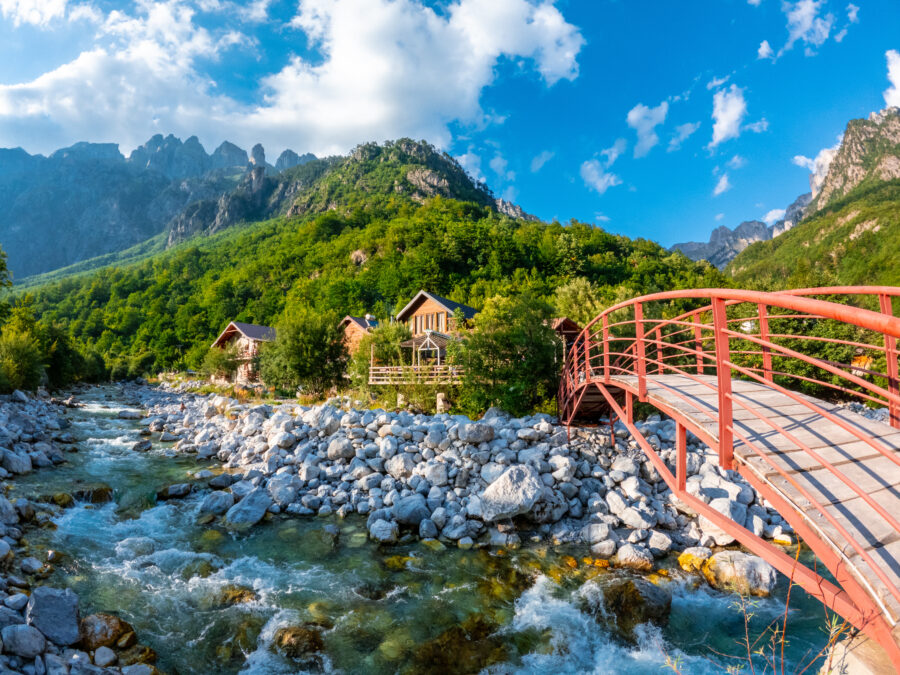
Deep in the Albanian Alps, Valbona Valley remains one of Europe’s last untouched mountain wildernesses—accessible only by spectacular ferry and mountain road.
Getting There & True Adventure
- Location: Northern Albania, Accursed Mountains
- Access: Ferry across Komani Lake + mountain transfer (€20 total, 5 hours from Shkodër)
- Accommodation: €15-30/night in family guesthouses
- Food: Home-cooked meals included (€5-8)
Pristine Wilderness
The Valbona-Theth hike ranks among Europe’s most spectacular day walks, crossing a 1,795m pass between two stunning valleys. The trail passes through beech forests, alpine meadows, and traditional villages seemingly frozen in time.
Valbona River runs crystal clear through the valley—perfect for swimming on hot days. Multiple day hikes explore surrounding peaks, all free except for minimal park fees (€1).
Cultural Immersion
Stay in traditional stone houses where families offer genuine hospitality—expect home-distilled raki, fresh dairy products, and stories translated through gestures and smiles.
Essential Tip: Bring cash (euros accepted)—no ATMs exist in the valley. Book guesthouses ahead in July-August when the Albanian diaspora returns home.
See Related: Must-Visit Hidden European Towns Perfect for Your Next Road Trip
11. Torla-Ordesa, Spain – Pyrenean Perfection
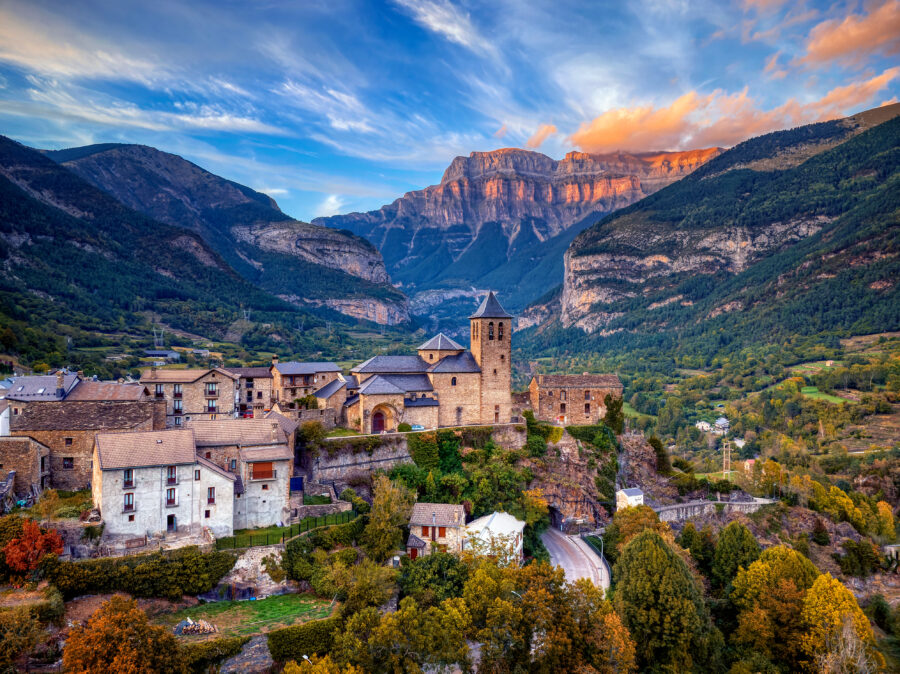
This tiny stone village guards the entrance to Ordesa y Monte Perdido National Park—Spain’s answer to Yosemite, with a fraction of the visitors.
Getting There & Park Logistics
- Location: Spanish Pyrenees, Huesca Province
- Access: Buses from Zaragoza (€15, 3 hours) or rental car
- Accommodation: €40-70/night in village
- Park Entry: Free, mandatory shuttle in summer (€5)
Dramatic Landscapes
The Ordesa Valley stretches 15km between 3,000m limestone walls—Europe’s Grand Canyon in miniature. The classic hike to Cola de Caballo waterfall takes 6 hours round-trip through changing ecosystems.
For panoramic views without the crowds, hike the Faja de Pelay trail—a balcony path carved into the valley’s north wall offering bird’s-eye perspectives.
Medieval Charm
Torla’s stone architecture dates to the 16th century, with narrow streets barely changed since medieval times. The village comes alive during the Carnaval de Torla (February), featuring pagan traditions predating Christianity.
Foodie Alert: Try chiretas (lamb stomach stuffed with rice and meat) at Casa Fau—mountain comfort food at its finest (€14).
12. Štrbské Pleso, Slovakia – Glacial Lake Luxury
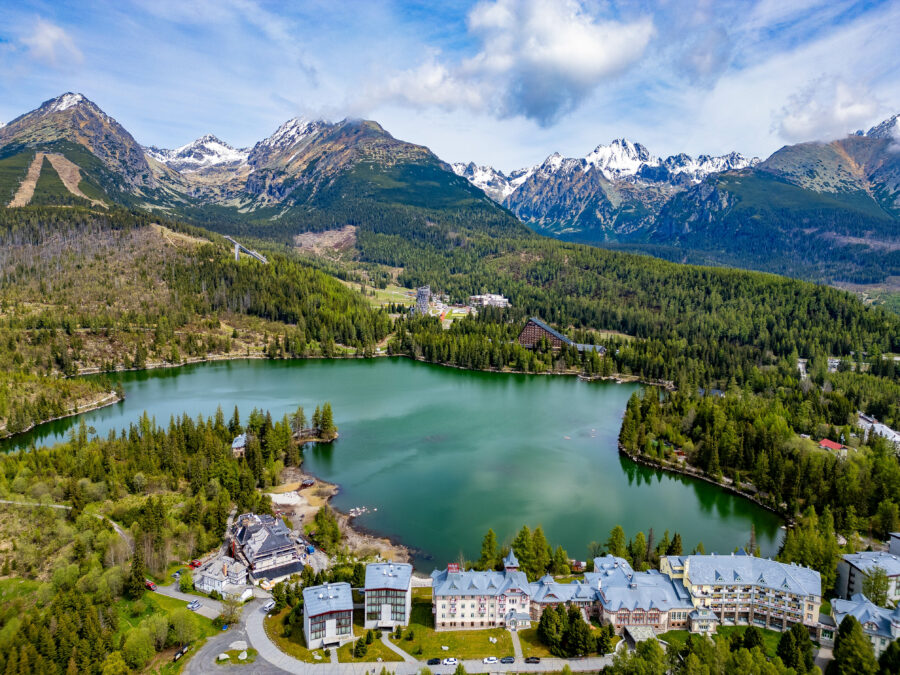
Slovakia’s premier mountain resort punches above its weight—delivering Swiss-style amenities at Slovak prices around a stunning glacial lake.
Getting There & Resort Reality
- Location: High Tatras, 1,346m elevation
- Access: Electric train from Poprad (€3, 30 minutes)
- Accommodation: €60-120/night for lakeside hotels
- Activities: Free hiking, affordable skiing (€30/day)
Lake Life
The namesake glacial lake offers a 2km shoreline walk with mountain reflections, especially stunning during autumn’s golden larches. Predné Solisko cable car (€14) accesses panoramic viewpoints and high-altitude trails.
Four-Season Appeal
Summer brings hikers, autumn photographers, and winter delivers Slovakia’s most reliable skiing. Spring sees fewer visitors but stunning wildflower meadows.
Splurge-Worthy: The Grand Hotel Kempinski (€150/night) offers five-star luxury at three-star Swiss prices—book the mountain-view spa package.
13. Theth, Albania – The Village Time Forgot
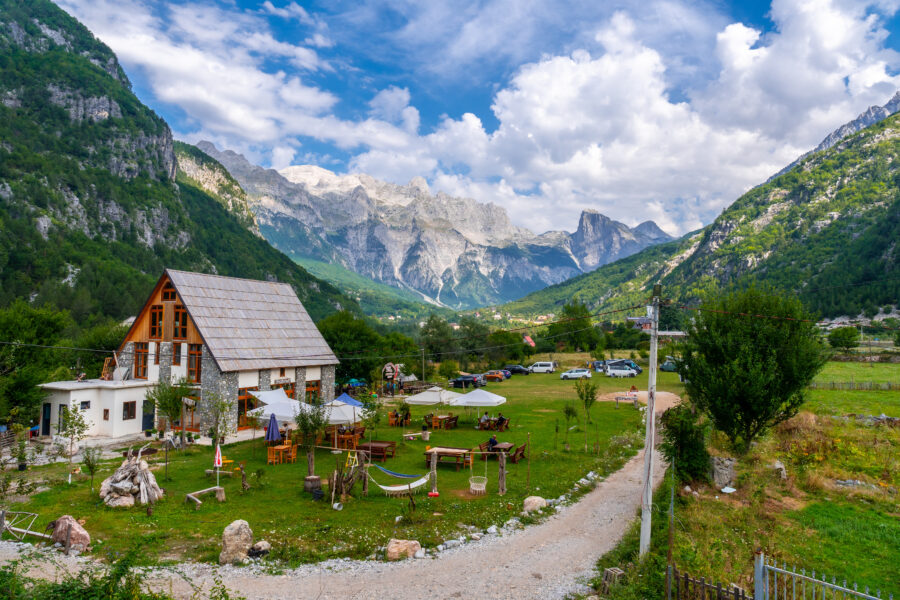
Isolated in a valley surrounded by 2,500m peaks, Theth preserves traditional Albanian mountain life in one of Europe’s most dramatic settings.
Getting There & Authentic Experience
- Location: Albanian Alps, Shkodër County
- Access: Minibus from Shkodër (€5, 3 hours on rough roads)
- Accommodation: €15-25/night including meals
- Season: June-September only (road closes in winter)
Natural Attractions
The Blue Eye of Theth—a turquoise spring pool—requires a 45-minute hike through forests. Grunas Waterfall plunges 25m into a swimming hole perfect for hot summer days.
Traditional kulla (tower houses) dot the village—defensive structures from blood feud days, now converted to guesthouses.
Hiking Paradise
Besides the famous Valbona crossing, trails lead to Montenegrin border peaks, abandoned villages, and highland pastures where shepherds spend summers.
Cultural Note: Respect local customs—modest dress and asking permission before photographing people ensures warm welcomes.
14. Kolasin, Montenegro – The Accessible Alternative

Often called “Montenegro’s Switzerland,” Kolasin offers mountain scenery without mountain challenges—perfect for those wanting Alpine beauty with easier access.
Getting There & Comfort Level
- Location: Central Montenegro, Bjelasica Mountains
- Access: Buses from Podgorica (€5, 1.5 hours)
- Accommodation: €25-60/night from hostels to spa resorts
- National Park Entry: €2/day for Biogradska Gora
Pristine Nature
Biogradska Gora National Park protects one of Europe’s last primeval forests—500-year-old trees surround a glacial lake accessible by easy walking paths. Rent bikes (€10/day) to explore deeper forest trails.
The Bjelasica Mountains offer hiking for all levels—from lakeside strolls to 2,139m peaks with Adriatic views on clear days.
Year-Round Activities
Winter skiing at Kolašin 1450 and Kolašin 1600 resorts costs a fraction of Alpine prices. Summer brings rafting on the Tara River and zip-lining through forest canopies.
Wellness Bonus: Several hotels offer spa packages using local thermal waters—perfect for post-hike recovery (from €60/night including treatments).
15. Aínsa, Spain – Where Mountains Meet History
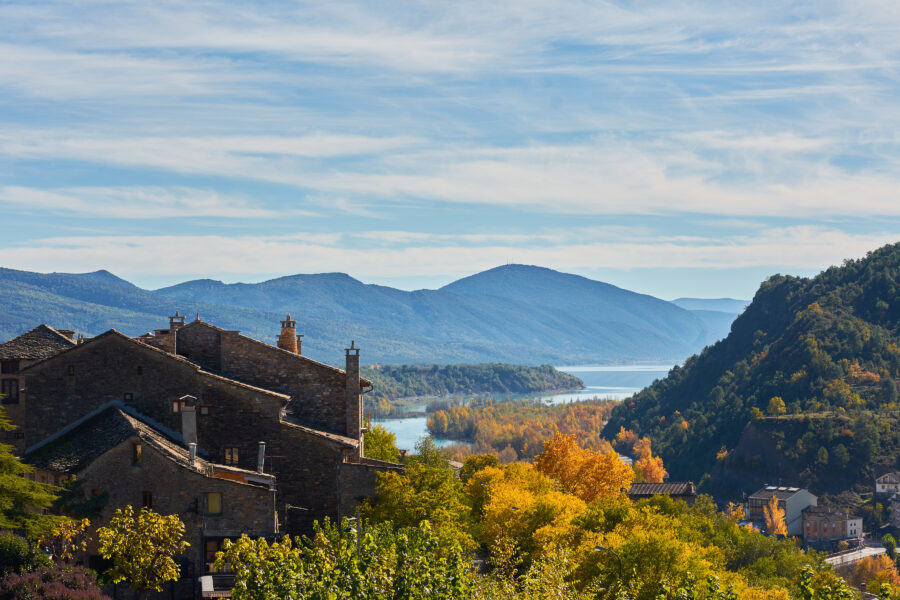
This medieval jewel perches above the convergence of two rivers with the Pyrenees as a backdrop, offering culture vultures their mountain fix.
Getting There & Practical Magic
- Location: Huesca Province, Pyrenean foothills
- Access: Buses from Barbastro (€5, 1 hour) or rental car
- Accommodation: €35-65/night in converted medieval buildings
- Village Entry: Free to explore
Timeless Wandering
The Plaza Mayor—one of Spain’s finest medieval squares—has hosted markets since the 11th century under stone arcades. Climb the castle ruins for 360-degree views of the Pyrenees and Ordesa National Park.
The village serves as an ideal base for exploring three national parks: Ordesa, Sierra de Guara, and Posets-Maladeta.
Adventure Hub
Beyond history, Aínsa has reinvented itself as an outdoor capital. Mountain biking trails earned international recognition, while the Mediano Reservoir offers flat-water kayaking with mountain views.
Festival Highlight: September’s Morisma reenacts medieval Christian-Moorish battles with the entire village participating—book accommodation months ahead.
See Related: Europe by Rail: The New Age of High-Speed Train Travel
Planning Your Budget Mountain Escape
When to Go
- Summer (June-September): Peak hiking season, warmest weather, all destinations accessible
- Autumn (October-November): Fewer crowds, golden colors, variable weather
- Winter (December-March): Skiing bargains, cozy mountain towns, some roads closed
- Spring (April-May): Wildflowers, waterfalls at peak flow, possible snow at altitude
Budget Breakdown (per person/day)
- Accommodation: €20-60 (guesthouses to mid-range hotels)
- Meals: €15-25 (breakfast included, lunch picnic, restaurant dinner)
- Activities: €0-40 (hiking free, cable cars/guided tours extra)
- Transport: €5-15 (local buses and trains)
- Total Daily Budget: €40-100 depending on comfort level
Essential Gear
- Hiking boots: Waterproof with ankle support [Affiliate opportunity: hiking gear guide]
- Layers: Mountain weather changes quickly
- Rain jacket: Lightweight but waterproof
- Day pack: 20-30L capacity sufficient
- Trekking poles: Helpful for steep terrain
- Offline maps: Download before losing signal
Money-Saving Strategies
- Book Direct: Contact accommodations directly for better rates
- Shoulder Season: May/June and September/October offer ideal weather with lower prices
- Shop Locally: Village markets and local restaurants cost half of tourist zones
- Free Activities: Hiking trails, village exploration, and swimming holes cost nothing
- Regional Passes: Many areas offer tourist cards with transport and activity discounts
Safety Considerations
- Travel Insurance: Essential for mountain activities—ensure coverage includes hiking/skiing [Affiliate opportunity: travel insurance comparison]
- Weather: Check forecasts and be prepared to change plans
- Trail Conditions: Ask locally about current conditions
- Emergency Numbers: 112 works throughout Europe
- Respect Limits: Mountain weather and terrain demand respect
Your Alpine Adventure Awaits
These 15 hidden mountain towns prove that Europe’s most spectacular scenery doesn’t require Swiss bank accounts. From Romania’s vampire-haunted peaks to Albania’s pristine valleys, each destination offers its blend of natural beauty, cultural authenticity, and budget-friendly prices.
Whether you’re seeking adrenaline-pumping adventures, peaceful lake reflections, or simply a cozy mountain refuge, these affordable alternatives deliver experiences that match—and often exceed—their famous Alpine cousins. The mountains are calling, and now you can afford to answer.
Ready to plan your budget mountain escape? Save this guide and start plotting your route through Europe’s best-kept Alpine secrets. Your wallet (and Instagram feed) will thank you.
[Internal linking opportunities: “Essential Europe Train Travel Guide,” “Best Travel Insurance for Adventure Travel,” “Complete European Hiking Gear Guide”]Note: Prices and availability are current as of July 2025. Always verify opening times and book accommodations in advance during peak season (July-August, Christmas-New Year).

